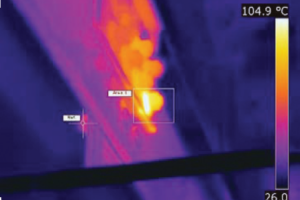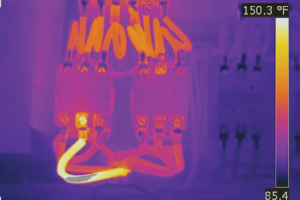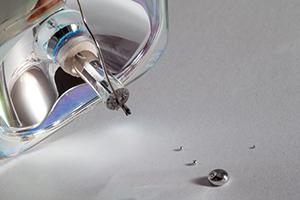Electrical preventive maintenance for small businesses
Inadequately maintained electrical systems are a leading cause of business interruption, poor energy efficiency, and premature equipment breakdown. A well planned and executed electrical preventive maintenance (EPM) program will reduce equipment failures, unplanned down time and unbudgeted expenditures. Unfortunately, many small businesses do not have the technical personnel experienced with EPM programs. This guide serves as an overview describing the basic components of an effective EPM program.
Safety
An EPM program involves working with electrically energized and mechanical equipment. Only personnel properly trained and qualified personnel should work on electrical equipment. All work associated with electrical power systems and equipment should be performed in accordance with applicable federal and local regulation, including OSHA electrical safety regulations and the equipment manufacturer’s instructions.
EPM programs
EPM programs are the scheduled inspection, testing and maintenance of critical electrical components and their support systems. The intent of an EPM program is to identify and address any issues before a failure occurs. For an EPM program to achieve long-term success, it must be well defined, well understood and properly implemented and documented. EPM programs require a financial commitment to spend a little now to prevent a major unexpected cost later.
There are three basic steps to make this happen:
Assess — What is the amount of lost time and product that can be attributed to failures? What in-house technical resources are available? Are one-line drawings of the power system available? Are the critical production components and their support circuits known? What is the age and overall condition of the equipment? These questions should be answered during the assessment stage.
Implement — This step involves both planning and accomplishing the work. The required maintenance activities and frequencies, as well as the procedures and schedules to accomplish the work should be documented. An individual should be assigned to oversee the program. Once these steps are completed, the work should be accomplished according to plan and the results documented.
Sustain — The ongoing execution of the program is critical. The program results should be reviewed and be utilized as an input to continuously improve the program.
Technical components of an EPM program
EPM programs involve maintenance and testing activities to keep electrical apparatus clean, cool, dry and tight. These activities should be scheduled based on the condition of the equipment, historical information concerning the equipment and the manufacturer’s recommendations. If no guidance is available, Hartford Steam Boiler Inspection and Insurance Company (HSB) recommends that electrical preventive maintenance be performed at three-year intervals. More frequent maintenance should occur if conditions warrant.
Keep it clean and dry
Electrical equipment rooms should be:
- Free of excessive dust and dirt
- Used for electrical equipment only and not for general storage
- Accessible only to qualified personnel
- Adequately illuminated
- Free from airborne contaminates
- Free from water or potential sources of water
Electrical equipment should be:
- Free from signs of moisture contamination
- Vacuumed to remove loose dirt or debris
- Maintained according to the manufacturers’ recommendations
Keep it cool
Minimize heat buildup in electrical apparatus and in equipment rooms by:
- Keeping outside surfaces clean
- Maintaining cooling fans or blowers
- Keeping ventilation openings clean and free from obstruction
- Maintaining any filters according to manufacturers’ recommendations
- Inspecting seals and gaskets and repairing or replacing as needed
Keep it tight
Electrical connections should be inspected for:
- Arcing
- Corrosion
- Hot spots using infrared thermography
- Proper tightness and connection torque values
The above suggestions are basic checks and inspections to minimize the most common and frequent problems. However, these checks and inspections do not constitute a comprehensive EPM program. Additional testing and maintenance activities based on a facility’s components and sensitivity to down time are required for a complete EPM program.
See Standard for an Electrical Preventive Maintenance (EPM) Program. Experienced electrical contractors and testing companies should also be consulted when deemed appropriate.
Conclusion
It is important to fully understand and implement an EPM program. An effective EPM program will reduce equipment failures as well as unplanned downtime. The time and effort to establish, implement and maintain an effective program is well worth the effort.
For further reading
Additional information is available by signing in to our Hanover Risk Solutions Partners page under Training Resources — Munich RE/Hartford Steam Boiler.
Copyright ©2017, The Hartford Steam Boiler Inspection and Insurance Company
This material is provided for informational purposes only and does not provide any coverage or guarantee loss prevention. The examples in this material are provided as hypothetical and for illustration purposes only. The Hanover Insurance Company and its affiliates and subsidiaries (“The Hanover”) specifically disclaim any warranty or representation that acceptance of any recommendations contained herein will make any premises, or operation safe or in compliance with any law or regulation. By providing this information to you, The Hanover does not assume (and specifically disclaims) any duty, undertaking or responsibility to you. The decision to accept or implement any recommendation(s) or advice contained in this material must be made by you.
LC FEB 2019 10-416 H
171-0847 (01/19)
Related resources
Electrical preventive maintenance for small businesses
Inadequately maintained electrical systems are a leading cause of business interruption, poor energy efficiency, and premature equipment breakdown. A well planned and executed electrical preventive maintenance (EPM) program will reduce equipment failures, unplanned down time and unbudgeted expenditures. Unfortunately, many small businesses do not have the technical personnel experienced with EPM programs. This guide serves as an overview describing the basic components of an effective EPM program.
Safety
An EPM program involves working with electrically energized and mechanical equipment. Only personnel properly trained and qualified personnel should work on electrical equipment. All work associated with electrical power systems and equipment should be performed in accordance with applicable federal and local regulation, including OSHA electrical safety regulations and the equipment manufacturer’s instructions.
EPM programs
EPM programs are the scheduled inspection, testing and maintenance of critical electrical components and their support systems. The intent of an EPM program is to identify and address any issues before a failure occurs. For an EPM program to achieve long-term success, it must be well defined, well understood and properly implemented and documented. EPM programs require a financial commitment to spend a little now to prevent a major unexpected cost later.
There are three basic steps to make this happen:
Assess — What is the amount of lost time and product that can be attributed to failures? What in-house technical resources are available? Are one-line drawings of the power system available? Are the critical production components and their support circuits known? What is the age and overall condition of the equipment? These questions should be answered during the assessment stage.
Implement — This step involves both planning and accomplishing the work. The required maintenance activities and frequencies, as well as the procedures and schedules to accomplish the work should be documented. An individual should be assigned to oversee the program. Once these steps are completed, the work should be accomplished according to plan and the results documented.
Sustain — The ongoing execution of the program is critical. The program results should be reviewed and be utilized as an input to continuously improve the program.
Technical components of an EPM program
EPM programs involve maintenance and testing activities to keep electrical apparatus clean, cool, dry and tight. These activities should be scheduled based on the condition of the equipment, historical information concerning the equipment and the manufacturer’s recommendations. If no guidance is available, Hartford Steam Boiler Inspection and Insurance Company (HSB) recommends that electrical preventive maintenance be performed at three-year intervals. More frequent maintenance should occur if conditions warrant.
Keep it clean and dry
Electrical equipment rooms should be:
- Free of excessive dust and dirt
- Used for electrical equipment only and not for general storage
- Accessible only to qualified personnel
- Adequately illuminated
- Free from airborne contaminates
- Free from water or potential sources of water
Electrical equipment should be:
- Free from signs of moisture contamination
- Vacuumed to remove loose dirt or debris
- Maintained according to the manufacturers’ recommendations
Keep it cool
Minimize heat buildup in electrical apparatus and in equipment rooms by:
- Keeping outside surfaces clean
- Maintaining cooling fans or blowers
- Keeping ventilation openings clean and free from obstruction
- Maintaining any filters according to manufacturers’ recommendations
- Inspecting seals and gaskets and repairing or replacing as needed
Keep it tight
Electrical connections should be inspected for:
- Arcing
- Corrosion
- Hot spots using infrared thermography
- Proper tightness and connection torque values
The above suggestions are basic checks and inspections to minimize the most common and frequent problems. However, these checks and inspections do not constitute a comprehensive EPM program. Additional testing and maintenance activities based on a facility’s components and sensitivity to down time are required for a complete EPM program.
See Standard for an Electrical Preventive Maintenance (EPM) Program. Experienced electrical contractors and testing companies should also be consulted when deemed appropriate.
Conclusion
It is important to fully understand and implement an EPM program. An effective EPM program will reduce equipment failures as well as unplanned downtime. The time and effort to establish, implement and maintain an effective program is well worth the effort.
For further reading
Additional information is available by signing in to our Hanover Risk Solutions Partners page under Training Resources — Munich RE/Hartford Steam Boiler.
Copyright ©2017, The Hartford Steam Boiler Inspection and Insurance Company
This material is provided for informational purposes only and does not provide any coverage or guarantee loss prevention. The examples in this material are provided as hypothetical and for illustration purposes only. The Hanover Insurance Company and its affiliates and subsidiaries (“The Hanover”) specifically disclaim any warranty or representation that acceptance of any recommendations contained herein will make any premises, or operation safe or in compliance with any law or regulation. By providing this information to you, The Hanover does not assume (and specifically disclaims) any duty, undertaking or responsibility to you. The decision to accept or implement any recommendation(s) or advice contained in this material must be made by you.
LC FEB 2019 10-416 H
171-0847 (01/19)
Related resources
Electrical preventive maintenance for small businesses
Inadequately maintained electrical systems are a leading cause of business interruption, poor energy efficiency, and premature equipment breakdown. A well planned and executed electrical preventive maintenance (EPM) program will reduce equipment failures, unplanned down time and unbudgeted expenditures. Unfortunately, many small businesses do not have the technical personnel experienced with EPM programs. This guide serves as an overview describing the basic components of an effective EPM program.
Safety
An EPM program involves working with electrically energized and mechanical equipment. Only personnel properly trained and qualified personnel should work on electrical equipment. All work associated with electrical power systems and equipment should be performed in accordance with applicable federal and local regulation, including OSHA electrical safety regulations and the equipment manufacturer’s instructions.
EPM programs
EPM programs are the scheduled inspection, testing and maintenance of critical electrical components and their support systems. The intent of an EPM program is to identify and address any issues before a failure occurs. For an EPM program to achieve long-term success, it must be well defined, well understood and properly implemented and documented. EPM programs require a financial commitment to spend a little now to prevent a major unexpected cost later.
There are three basic steps to make this happen:
Assess — What is the amount of lost time and product that can be attributed to failures? What in-house technical resources are available? Are one-line drawings of the power system available? Are the critical production components and their support circuits known? What is the age and overall condition of the equipment? These questions should be answered during the assessment stage.
Implement — This step involves both planning and accomplishing the work. The required maintenance activities and frequencies, as well as the procedures and schedules to accomplish the work should be documented. An individual should be assigned to oversee the program. Once these steps are completed, the work should be accomplished according to plan and the results documented.
Sustain — The ongoing execution of the program is critical. The program results should be reviewed and be utilized as an input to continuously improve the program.
Technical components of an EPM program
EPM programs involve maintenance and testing activities to keep electrical apparatus clean, cool, dry and tight. These activities should be scheduled based on the condition of the equipment, historical information concerning the equipment and the manufacturer’s recommendations. If no guidance is available, Hartford Steam Boiler Inspection and Insurance Company (HSB) recommends that electrical preventive maintenance be performed at three-year intervals. More frequent maintenance should occur if conditions warrant.
Keep it clean and dry
Electrical equipment rooms should be:
- Free of excessive dust and dirt
- Used for electrical equipment only and not for general storage
- Accessible only to qualified personnel
- Adequately illuminated
- Free from airborne contaminates
- Free from water or potential sources of water
Electrical equipment should be:
- Free from signs of moisture contamination
- Vacuumed to remove loose dirt or debris
- Maintained according to the manufacturers’ recommendations
Keep it cool
Minimize heat buildup in electrical apparatus and in equipment rooms by:
- Keeping outside surfaces clean
- Maintaining cooling fans or blowers
- Keeping ventilation openings clean and free from obstruction
- Maintaining any filters according to manufacturers’ recommendations
- Inspecting seals and gaskets and repairing or replacing as needed
Keep it tight
Electrical connections should be inspected for:
- Arcing
- Corrosion
- Hot spots using infrared thermography
- Proper tightness and connection torque values
The above suggestions are basic checks and inspections to minimize the most common and frequent problems. However, these checks and inspections do not constitute a comprehensive EPM program. Additional testing and maintenance activities based on a facility’s components and sensitivity to down time are required for a complete EPM program.
See Standard for an Electrical Preventive Maintenance (EPM) Program. Experienced electrical contractors and testing companies should also be consulted when deemed appropriate.
Conclusion
It is important to fully understand and implement an EPM program. An effective EPM program will reduce equipment failures as well as unplanned downtime. The time and effort to establish, implement and maintain an effective program is well worth the effort.
For further reading
Additional information is available by signing in to our Hanover Risk Solutions Partners page under Training Resources — Munich RE/Hartford Steam Boiler.
Copyright ©2017, The Hartford Steam Boiler Inspection and Insurance Company
This material is provided for informational purposes only and does not provide any coverage or guarantee loss prevention. The examples in this material are provided as hypothetical and for illustration purposes only. The Hanover Insurance Company and its affiliates and subsidiaries (“The Hanover”) specifically disclaim any warranty or representation that acceptance of any recommendations contained herein will make any premises, or operation safe or in compliance with any law or regulation. By providing this information to you, The Hanover does not assume (and specifically disclaims) any duty, undertaking or responsibility to you. The decision to accept or implement any recommendation(s) or advice contained in this material must be made by you.
LC FEB 2019 10-416 H
171-0847 (01/19)
Related resources
Electrical preventive maintenance for small businesses
Inadequately maintained electrical systems are a leading cause of business interruption, poor energy efficiency, and premature equipment breakdown. A well planned and executed electrical preventive maintenance (EPM) program will reduce equipment failures, unplanned down time and unbudgeted expenditures. Unfortunately, many small businesses do not have the technical personnel experienced with EPM programs. This guide serves as an overview describing the basic components of an effective EPM program.
Safety
An EPM program involves working with electrically energized and mechanical equipment. Only personnel properly trained and qualified personnel should work on electrical equipment. All work associated with electrical power systems and equipment should be performed in accordance with applicable federal and local regulation, including OSHA electrical safety regulations and the equipment manufacturer’s instructions.
EPM programs
EPM programs are the scheduled inspection, testing and maintenance of critical electrical components and their support systems. The intent of an EPM program is to identify and address any issues before a failure occurs. For an EPM program to achieve long-term success, it must be well defined, well understood and properly implemented and documented. EPM programs require a financial commitment to spend a little now to prevent a major unexpected cost later.
There are three basic steps to make this happen:
Assess — What is the amount of lost time and product that can be attributed to failures? What in-house technical resources are available? Are one-line drawings of the power system available? Are the critical production components and their support circuits known? What is the age and overall condition of the equipment? These questions should be answered during the assessment stage.
Implement — This step involves both planning and accomplishing the work. The required maintenance activities and frequencies, as well as the procedures and schedules to accomplish the work should be documented. An individual should be assigned to oversee the program. Once these steps are completed, the work should be accomplished according to plan and the results documented.
Sustain — The ongoing execution of the program is critical. The program results should be reviewed and be utilized as an input to continuously improve the program.
Technical components of an EPM program
EPM programs involve maintenance and testing activities to keep electrical apparatus clean, cool, dry and tight. These activities should be scheduled based on the condition of the equipment, historical information concerning the equipment and the manufacturer’s recommendations. If no guidance is available, Hartford Steam Boiler Inspection and Insurance Company (HSB) recommends that electrical preventive maintenance be performed at three-year intervals. More frequent maintenance should occur if conditions warrant.
Keep it clean and dry
Electrical equipment rooms should be:
- Free of excessive dust and dirt
- Used for electrical equipment only and not for general storage
- Accessible only to qualified personnel
- Adequately illuminated
- Free from airborne contaminates
- Free from water or potential sources of water
Electrical equipment should be:
- Free from signs of moisture contamination
- Vacuumed to remove loose dirt or debris
- Maintained according to the manufacturers’ recommendations
Keep it cool
Minimize heat buildup in electrical apparatus and in equipment rooms by:
- Keeping outside surfaces clean
- Maintaining cooling fans or blowers
- Keeping ventilation openings clean and free from obstruction
- Maintaining any filters according to manufacturers’ recommendations
- Inspecting seals and gaskets and repairing or replacing as needed
Keep it tight
Electrical connections should be inspected for:
- Arcing
- Corrosion
- Hot spots using infrared thermography
- Proper tightness and connection torque values
The above suggestions are basic checks and inspections to minimize the most common and frequent problems. However, these checks and inspections do not constitute a comprehensive EPM program. Additional testing and maintenance activities based on a facility’s components and sensitivity to down time are required for a complete EPM program.
See Standard for an Electrical Preventive Maintenance (EPM) Program. Experienced electrical contractors and testing companies should also be consulted when deemed appropriate.
Conclusion
It is important to fully understand and implement an EPM program. An effective EPM program will reduce equipment failures as well as unplanned downtime. The time and effort to establish, implement and maintain an effective program is well worth the effort.
For further reading
Additional information is available by signing in to our Hanover Risk Solutions Partners page under Training Resources — Munich RE/Hartford Steam Boiler.
Copyright ©2017, The Hartford Steam Boiler Inspection and Insurance Company
This material is provided for informational purposes only and does not provide any coverage or guarantee loss prevention. The examples in this material are provided as hypothetical and for illustration purposes only. The Hanover Insurance Company and its affiliates and subsidiaries (“The Hanover”) specifically disclaim any warranty or representation that acceptance of any recommendations contained herein will make any premises, or operation safe or in compliance with any law or regulation. By providing this information to you, The Hanover does not assume (and specifically disclaims) any duty, undertaking or responsibility to you. The decision to accept or implement any recommendation(s) or advice contained in this material must be made by you.
LC FEB 2019 10-416 H
171-0847 (01/19)








